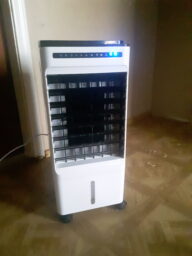
Hi, K here, partnering with Phoenix on homesteading. One of my biggest challenges in off-grid living has been indoor climate-control without using too much electricity. Traditional HVAC systems take up way too much electricity to be practical for off-grid life. We use evaporative coolers, which as the name indicates transforms liquid water into vapor. Evaporation uses up a lot of heat in the air, thus cooling the space around it.
Evaporative coolers work pretty well when humidity isn’t high, like in early and late summer. Although we live in a desert area, there is a yearly rain period from mid-June to mid-August, referred to as the monsoon season. During this time, the evaporative coolers lose their efficiency. During this rainy season, we’re using fans and looking into more efficient solutions. It is challenging because this is the available cost-effective technology, and we are still really hot inside the house. We anticipate this situation will be exacerbated with climate change.
You can work up to the heating and cooling challenge by practicing while on the grid.
If you have an electric HVAC system, turn the thermostat up in the summer and down in the winter. Dress appropriately for the temperatures you have decided on. Experiment with passive thermal cooling and heating. In the summer, when the nighttime temperatures drop, open your windows and doors to naturally cool your living space, then close them just before sunrise. This keeps your home cool longer without running your A/C. In the winter do the opposite, opening your drapes on the side of the house where the sun is shining and letting the solar thermals heat your house without running your heater as much. You’ll be surprised how much of a difference this makes. Use weather stripping on all your windows and doors; this will cut down on air infiltration.
Moving from an environment you control to one that someone else controls (e.g. office, grocery store, etc) can be a difficult adjustment. Your body never quite knows what to do to self-regulate. Just know you’ll be uncomfortable at times as you experiment with these energy-saving strategies.
If you’re thinking of painting your house, use the project to insulate as well. NASA invented a type of ceramic thermacell to paint their shuttles with as a heat shield. They discovered it had some amazing insulative properties as well. Essentially, you mix it into your paint, and paint as usual. Two coats provide the equivalent of around R-19 insulation, depending on the brand. This will make your house more comfortable, and reduce your heating and cooling energy loads.
I’m looking into new cooling solutions for the monsoon season and will keep you posted.
Next blog post: Part 3: Possible solutions for your sustainable living–large appliances (By K)
